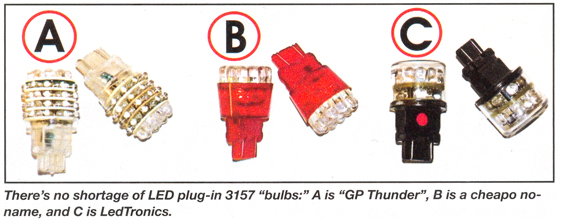Click to PDF file of excerpt of Mopar Actions's original article in print:
Mopar Action #41
With this installment's wrench-twisting out of the way, we turned our attention to lighting yet again. With the headlight upgrade from the last issue so
successful, we wanted to bring our taillamps up to contemporary standards. Longtime MA readers will recall our ground breaking LED taillamp upgrade way
back in the Dec., 2005 issue. For that swap, we disassembled the lens from the housing, and pirated the circuit boards from some trailer LED conversion kits,
which we jammed in. This has worked out 100% fine. We also checked out some 1157-based drop-in LED "bulbs," and found one clear winner — LEDtronics
(ledtronics.com), see video at tinyurl.com/maleds. Later, we put a pair of those in the Savvy Savoy project, where they were a perfect match for the small lens.

The [Dodge Ram Dakota] has what are, effectively, one-piece lens/reflector/housing assemblies that can't easily be disassembled. With no known aftermarket
drop-in complete LED lamp assemblies to be found,we knew it was gonna be a "bulb" swap, or nothing.
We again rounded up a wide assortment of "bulbs," this time in the [Dakota's] 3157 configuration. And, again, we found LEDtronics totally blew everything else
out of the water--their bulbs were over twice as bright as their closest competitor! Installation took about a minute per side (add another 30 seconds for a
variable-load flasher installation).
LED bulbs are different, conceptually and functionally, from stock incandescents. The older technology produces light in what is basically a pinpoint,
radiating the light almost a full 360° (only the base itself -blocks some output). A properly designed reflector will concentrate all this light onto the lens,
illuminating it totally. LED drop-ins, however, have the majority of the LEOs, which each have their own mini-lens built in, facing opposite the base, which, if
you're installing them into a suitable lamp, will have the LEOs shining towards the lens. However, due to diameter requirements, this has the effect of brightly
illuminating a smaller portion of the lens. Add a weak-sister conversion bulb to the mix, and you have an outcome that's inferior to the stock incandescent. Good
news: the LEDtronics conversions are so much brighter that the overall effect is a much brighter, attention-grabbing lamp. Besides this, there's the
almost-infinite life, resistance to vibration, reduced current draw, and, to us, the primary reason to swap to LED tails: Significantly less time for the brake
lights to illuminate. This can make the difference between being rear-ended or a near-miss.
The products used:
AUT1156, AUT1157 AUT3156, AUT3157
From MOPAR ACTION ONLINE Tech Q & A
Tech Question from the owner of a 1970 Dodge Challenger 340
Based on your 12-05 article I decided to install LEDtronics plug in units for all the 1157 bulbs (F&R) in my car. Also installed an
EL12 flasher. Now the turn signals take a couple seconds to activate, almost like they have to warm up. However, the four ways work like a charm. Any ideas why
this is happening? Turn signal switch? Appreciate any thoughts you have on the matter. Thank You.
Mark, because you have LEDs front AND rear, there's now almost zero load on the flasher. Although we didn't have room to mention it in the article, that's a
reason that we didn't recommend doing the fronts also.
The stock 32cp "bright" filaments drew about 2.1 amps each, so a stocker with one lamp at each end of the car placed a 4.2 A. load on the flasher, and a
three-lamp car, 6.3 amps. The LEDs cut this down to a few hundred milliamps, which is, as you've proven, insufficent to activate even the electronic flaser.
Either swap back to incandescent up front, or add dummy-load resistors in the circuit to place a load on the flasher. I'll guess that one ampere or so would be
enough. If that's true, at 13.5 volts, a 13.5 ohm resistor would be needed, and it would dissapate 13.5 watts. Since a 13.5 ohm resistor is non-standard, I'd go
with a 15 ohm, 20 watt wirewound resistor (Digi-Key, Radio Shack, etc.). If you want to try something more compact, a 20 ohm 10 watt might also do the job -- as
would hanging a bulb somewhere where it can't be seen.
Rick